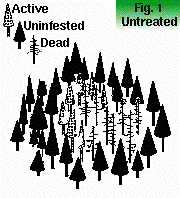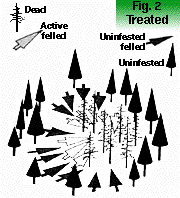- Identify, the currently infested (active) trees within the spot (the most recently attacked trees in an expanding infestation will have green foliage as well as pitch tubes and/or boring dust in bark crevices).

- Fall all active trees toward the center of the spot.

- Fall a horseshoe-shaped buffer of green, uninfested trees around the active head of the spot and leave them lying on the ground with crowns pointed toward the center of the spot. For small- to medium-sized spots (100 currently infested trees), the buffer should be as wide as the average height of the trees in the spot (40’-60’ wide). The buffer may need to be wider for large, rapidly expanding infestations.
- Old dead trees with no bark beetles remaining should be left standing to allow development of parasites and predators that help control bark beetle populations.
- If possible, check the treated spot after two weeks for re-infestations (breakouts) around the boundary. Re-treat all breakouts.
The buffer strip of green trees must be included to assure effective control, particularly for spots treated during warm months.